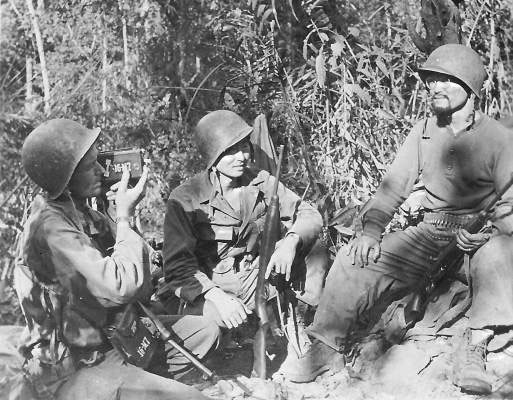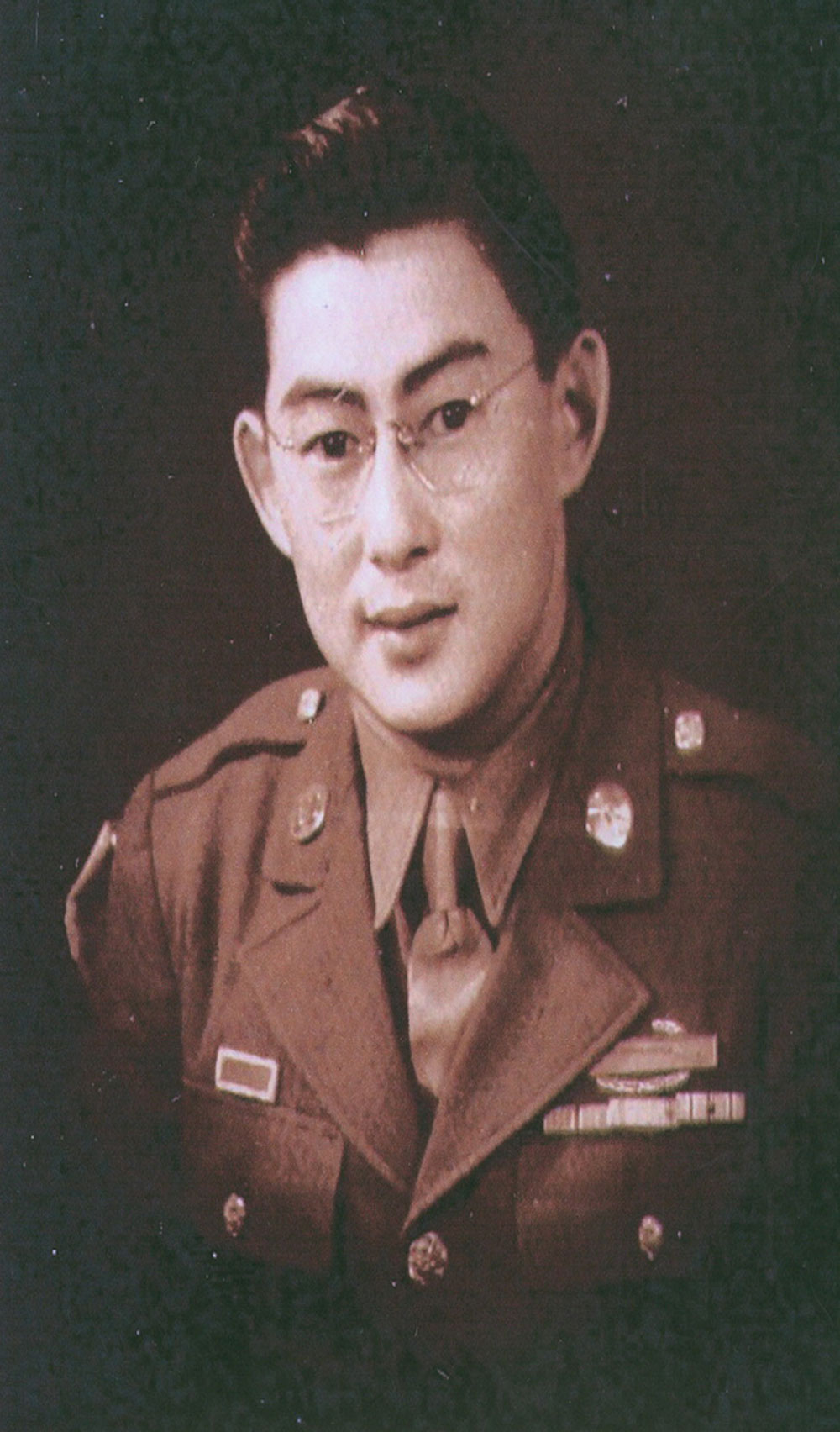
Merrill’s Marauders- Home
- History
- Conflict History
- China-Burma-India Theater
- Merrill’s Marauders
- Home
- History
- Conflict History
- China-Burma-India Theater
- Merrill’s Marauders
(February – August 1944)
With the Japanese occupying Burma from the beginning of the war, there was no land route for supplies to China. The only way to secure a supply route was to reopen the Burma Road and destroy Japanese communications and supply lines in the process.
The newly formed 5307 Composite Unit (Provisional) was put to the task. It was a group of 3,000 men, including 14 Military Intelligence Service (MIS) soldiers, who had all volunteered for “a dangerous and hazardous mission” codenamed GALAHAD, under the leadership of Brigadier General Frank A. Merrill.1 From February to August 1944, the Merrill’s Marauders, as the unit was later dubbed, played a part in the operations. Its main goal was to clear the north Burma area of Japanese troops and capture the town of Myitkyina, the capital city of the Kachin state and the country’s northernmost port.
From their training grounds in India, the Marauders marched up the Ledo Road and through more than 1,000 miles of the Himalayan mountain ranges into Burma. Trained in jungle warfare, the Marauders trekked through miles of dense, mountainous jungle. Along with enemy fire, they faced tropical disease and monsoon rains. They carried their gear on their backs or on mules.2 The soldiers participated in five major engagements (Walawbum, Shaduzup, Inkangahtawng, Nhpum Ga, and Myitkyina) and 30 minor ones altogether.
In August 1943, the Military Intelligence Service Language School (MISLS) had received a request for 14 MIS Nisei to assist the first US ground troops in Southeast Asia. Colonel Kai E. Rasmussen, head at MISLS, selected Japanese-born and raised First Lieutenant William A. Laffin as the team leader. The Nisei leader was Sergeant Edward Hideo Mitsukado, a court reporter from Hawaii. Half of their team was comprised of Kibei (educated in Japan) soldiers. Half were college graduates. Half were from Hawaii. Two Nisei each were assigned to six of the combat teams and two to headquarters.
By the time the Marauders had captured the town of Myitkyina and defeated the Japanese troops on August 3, the unit had been reduced to 15 percent of its original size. Most were medically evacuated, including Merrill himself and several MIS Nisei. Laffin, the MIS team leader, unfortunately was killed when his plane was shot down by the Japanese.
In early March 1944 at Walawbum, the main Japanese supply base in North Burma, Los Angeles-born Staff Sergeant Roy Hiroshi Matsumoto intercepted a message from a Japanese sergeant stating his concerns to his superior that just three of his men were guarding an ammunition dump. The Japanese soldiers spoke in a little-known dialect, which just happened to be one understood by Matsumoto. In relaying his message, the Japanese sergeant unwittingly gave away his location. Second Battalion was then able to locate the dump and destroy it.3 This was the first battle for the Marauders.4 For his service, Matsumoto was awarded the Legion of Merit.5
At Nhpum Ga, Matsumoto again displayed uncommon courage. The Japanese surrounded the 2nd Battalion, and they were under constant attack for eleven days. In the middle of the night, Matsumoto would crawl in the front of American lines to eavesdrop on the Japanese. One night, he learned of an early morning attack and was able to warn the Americans, who preempted the strike. In the middle of the assault, Matsumoto shouted an order in Japanese that confused the Japanese soldiers, causing them to forge on, right into the Americans’ trap. With this action, Matsumoto saved the lives of the Marauders. When asked by another sergeant why Matsumoto was not considered for the Medal of Honor for his heroism, Matsumoto’s commanding officer, Lieutenant Colonel George McGee, replied that “he was only an enlisted man doing his duty.”6
The Merrill’s Marauders were awarded the Distinguished Unit Citation (DUC) in July 1944 and disbanded in August of that year. In 1966, the DUC was redesignated as a Presidential Unit Citation. Every member of the Marauders also received a Bronze Star.
All 14 MIS soldiers were fortunate to survive the ordeal and received Combat Infantryman’s Badges. They included:
- Howard Furumoto
- Henry Gosho
- Grant J. Hirabayashi
- Robert Y. Honda
- Calvin T. Kobata
- Russell K. Kono
- Roy H. Matsumoto
- Edward Mitsukado
- Herbert Y. Miyasaki
- Roy K. Nakada
- Ben S. Sugeta
- Thomas K. Tsubota
- Jimmy Yamaguchi
- Akiji Yoshimura7
These men were the only intelligence servicemen fully recognized for their work during and immediately after the war. The Nisei of the Marauders were the most widely known Nisei in the Pacific war.8 General Merrill himself commended the MIS, stating, “As for the value of the Nisei group, I couldn’t have gotten along without them. Probably few realized that these boys did everything that an infantryman normally does plus the extra work of translating, interrogating, etc.”9
Footnotes
- 1“Unit History,” Merrill’s Marauders 5307 Composite Unit (Provisional), accessed January 2, 2015
- 2Ibid.
3“First Mission: Walawbum,” Merrill’s Marauders: February-May 1944 (Washington, DC: US Army Center of Military History, 1990), last updated June 29, 2001,. Also see Jack Broom, “Japanese-American soldier kept quiet about World War II heroics,” The Seattle Times, May 23, 2014.
- 4Thomas Tsubota, “From the 100th Battalion to Merrill’s Marauders,” Secret Valor: MIS Personnel World War II Pacific Theater (Honolulu, HI: Military Intelligence Service Veterans, 1993), p. 69.
- 5Some confusion surrounds Matsumoto’s Legion of Merit award, which was awarded for his heroism at Walawbum and not at Nhpum Ga. See James C. McNaughton, Nisei Linguists: Japanese Americans in the Military Intelligence Service during World War II (Washington, DC: US Army Center of Military History, 2006), p. 279. Also see “The History,” Honor and Sacrifice: The Roy Matsumoto Story,” accessed January 2, 2014.
- 6James Finley, qtd. in Jonathan J. Koester’s “History inspires, teaches military intelligence NCOs,” NCO Journal, June 17, 2014.
- 7“The Marauder Samurai,” Merrill’s Marauders 5307 Composite Unit (Provisional), accessed January 2, 2015.
- 8McNaughton, p. 284.
- 9“The Marauder Samurai.”
ORAL HISTORY CLIPS
INTERVIEWER: What was that like when you were first fired upon? HIRABAYASHI: Well actually, I often wanted to… is it bad to see the enemy or not to see the enemy, but I never saw a live enemy until I went to Myitkyina. We were fighting in the jungle. I heard the enemy, I heard them talk, but I never saw them. The only enemy I saw were dead.
Roy Matsumoto [interview 202]
Starts on Tape Five, between 24 and 26 minute marks[Roy Matsumoto describes his actions at Nhpum Ga, where he shouted commands in Japanese in order to get the Japanese troops to keep charging into the Americans’ trap.]
INTERVIEWER:
What exactly was the Merrill’s Marauders job as a unit?
ROY MATSUMOTO:
As a unit, disrupt communication and harass them and so that Chinese are pushing from two division from the top and annihilate them so that we be able to capture airstrip at Myitkyina so that plane fly in there then send goods, you know, supply through Burma Road. See, Burma Road’s open before, you know, Burma taken by Japanese. So they using that airstrip and supply the Chinese because the Chinese coast road sealed by Japanese navy.
Roy Matsumoto [interview 202]
Starts on Tape Seven, between 16 and 18 minute marks
ROY MATSUMOTO:
But what they did was first—they know where we were so they think we’re still there. So attack in darkness and just about (18:00) daybreak—so you can’t hardly, you know, see but still see, you know where going. They came back then know resistance, see. Then so they decided to go up more maybe—so they cannot figure out, no spur of moment, they cannot figure out, you know.
This not it so maybe up there. They thought maybe 10 yard but maybe another 10 yard. So we were about 10-15 yards above that foxhole. So all of a sudden they come up and pass the foxhole, open up with automatic, commence fire, see. Then all of a sudden about 40 to 50 weapons against the Arisaka, you know, 20, so that’s just like a playing toy, you know, against automatic weapon.
So they decided to, you know, back up and try to get in the foxhole to cover. Then it was a booby trap and so that’s hand grenades goes off, they trip wire, see. So then I see reinforcement there and try to come up. Then they talking about “hikekei.” That’s in the Japanese mean withdraw, see. Not retreat, they don’t say retreat, wasn’t the order. But they talking about so I, you know, countermanded their retreating order. Retreating order gonna come, see, so I know right away and some probably also already got killed, I don’t know. But I countermanded order then I give ’em a “totsugeki ni!” you know.
Then a “tsukume!” and “susume!” those thing. See, I didn’t say any English so—but anyway the Japanese that’s what I said. So in order to give ’em a move, you have to give ’em a preparatory order, otherwise they won’t listen. Fortunately, while I was in high school, all high school kid (20:00) in Japan have to take junior ROTC course and since I was curious I study then know what order to give make advance so that come in handy. So knowing the thing, you know, that’s why it says that my curiosity save my life with rest of those guy life.





